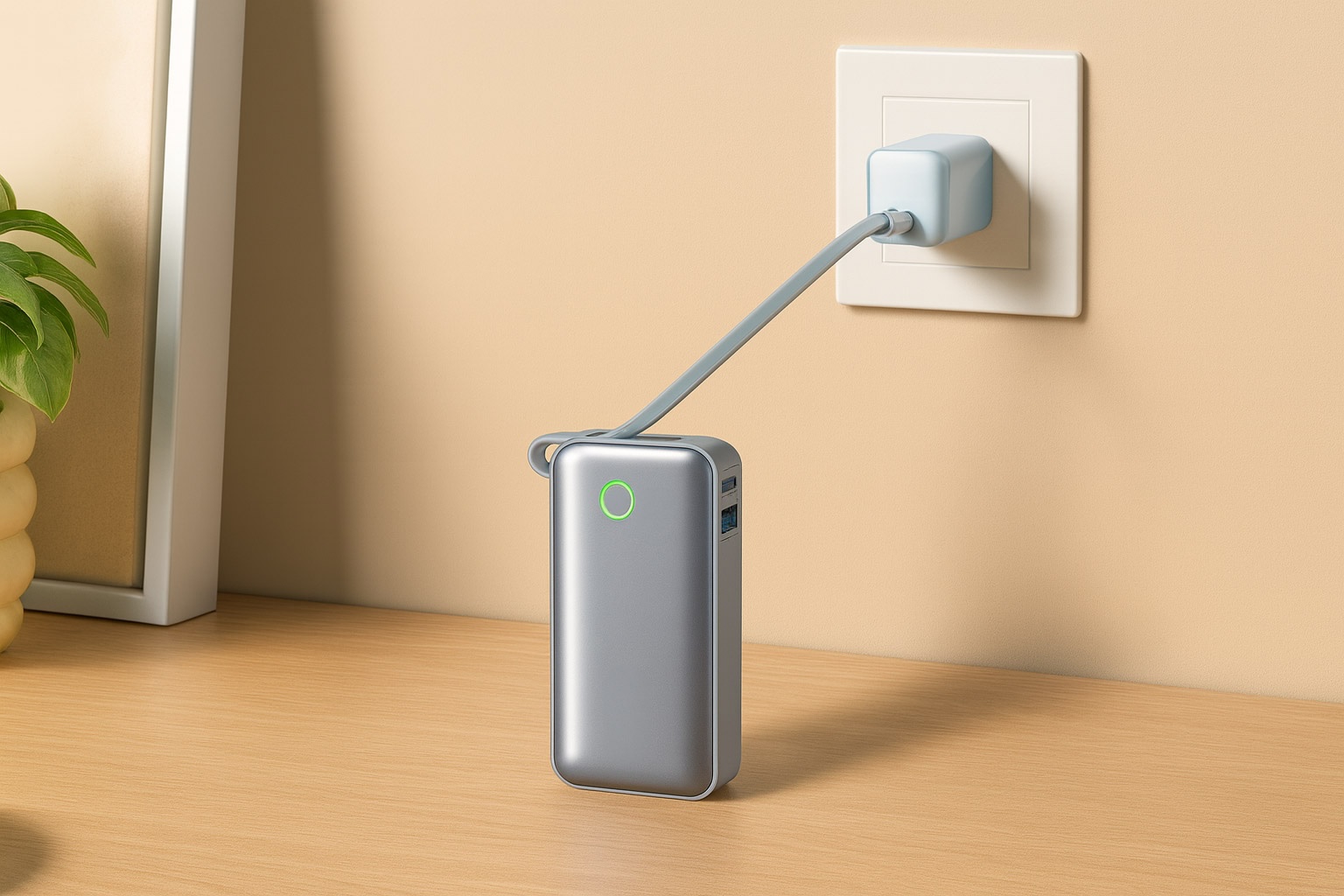- The contenders are Anker Nano Power Bank 5K (A1653), Anker Nano Power Bank 10K (A1259), and Baseus Compact Power Bank 5K, with capacities of 5,000 mAh, 10,000 mAh, and 5,000 mAh respectively.
- Anker Nano Power Bank 10K delivers up to 30W Power Delivery, supports two devices at a combined 24W, and recharges to 50% in about 45 minutes.
- Anker Nano Power Bank 5K provides up to 22.5W output via its fold-out USB-C connector, has a single USB-C port (no USB-A), and recharges fully in roughly two hours.
- Baseus Compact Power Bank 5K outputs 20W via USB-C, includes a fold-out USB-C plug for direct charging, and has a second USB-C port for input/output with no USB-A port.
- Anker Nano 5K weighs about 100 grams and uses a foldable USB-C connector, while Anker Nano 10K weighs 215 grams and includes a color OLED display and a built-in 70 cm USB-C cable.
- Baseus Compact 5K measures about 80 × 40.2 × 25.6 mm (~8 cm × 4 cm × 2.5 cm) and uses a slim rectangular form with indicators; some models use 3 white LEDs and 1 colored LED to show battery.
- In 2025, Anker released two new Nano models: a 5K MagGo with 15W wireless charging and a 10K 45W model with a longer retractable USB-C cable and a status display.
- Baseus has moved toward Qi2 wireless charging with its PicoGo 10K, and a potential 5K PicoGo with Qi2 and a stand is expected.
- Price snapshots show Anker Nano 5K around $29.99 with frequent sales to about $23.99, Anker Nano 10K typically $49.99–$59.99, and Baseus Compact 5K often around $34.99 but on sale to roughly $19.99–$20.
- Conclusion: for multi-device or laptop-like use, choose Anker Nano 10K; for ultra-portable daily backup, choose Anker Nano 5K; for best value, choose Baseus Compact 5K.
In the age of always-on gadgets, a reliable pocket-sized power bank is a must-have. Today we pit three of 2025’s most talked-about mini chargers against each other: Anker’s Nano Power Bank 10,000mAh, Anker Nano Power Bank 5,000mAh, and the Baseus Compact Power Bank 5,000mAh. These tiny but mighty battery packs promise to keep your phone alive through the day – but how do they compare on specs, speed, design, and value? In this comprehensive report, we’ll dissect each charger’s features, charging speeds, ports, compatibility, and even what experts and users are saying. We’ll also peek at current news (including upcoming models and recalls) from Anker and Baseus. By the end, you’ll know which of these compact chargers truly rules 2025 – and which one best fits your on-the-go power needs.
(Spoiler: All three are impressively capable for their size, but each has unique strengths and quirks!)
Meet the Contenders: Specs & Features at a Glance
Before diving deep, let’s compare the core specs and features of these power banks side by side:
| Feature | Anker Nano Power Bank 5K (A1653) | Anker Nano Power Bank 10K (A1259) | Baseus Compact Power Bank 5K |
|---|---|---|---|
| Capacity | 5,000 mAh (18.5 Wh) | 10,000 mAh (37 Wh) | 5,000 mAh (18.5 Wh) |
| Output (Max) | 22.5W (Power Delivery 20W, Quick Charge 18W, Huawei SCP 22.5W) | 30W (Power Delivery 30W single-port; 24W total when dual output) | 20W (Power Delivery 20W PD3.0 fast charge) [1] [2] |
| Ports & Connectors | – Foldable USB-C connector (integrated male plug) for direct phone charging – 1× USB-C port (female) for output to other devices or input to recharge – (No USB-A port) | – Built-in USB-C cable (fixed 2.3 ft cable doubles as a carry loop) – 1× USB-C port (bi-directional in/out) – 1× USB-A port (output for older devices) | – Foldable USB-C connector (integrated plug, similar to Anker 5K) [3] – 1× USB-C port (for recharging the bank and as an output port for cables) [4] [5] – (No separate USB-A port) |
| Recharge Speed (Input) | Up to 22.5W via USB-C (supports bi-directional fast charging). ~Under 2 hours for a full self-charge (est.) – supports passthrough charging. | Up to 30W via USB-C (supports 30W bi-directional fast charging) – power bank reaches 50% in ~45 minutes [6]. Full recharge ~1.5–2 hours with a strong adapter (supports passthrough). | Up to 12W (5V⎓2.4A) via USB-C input [7] (slower than Anker). Full recharge ~2+ hours. (Likely no official passthrough mode mentioned.) |
| Design & Build | Compact “lipstick-size” block (≈3.0 × 1.4 × 1.0 inches), ~100g. Cylindrical-rounded shape as wide as a phone. 5 LED battery indicator dots + a side button. 73% recycled plastic shell. Available in black (possibly other colors). | Sleek rectangular slab (≈10.4 × 5.2 × 2.6 cm) [8], heavier at 215g. Glossy front/back (fingerprint magnet) with textured sides. Color display on front shows exact % and even estimated hours remaining. Button to activate display. 80% recycled plastic casing [9]. Color: “Black Stone” (dark grey). | Pocket-friendly mini brick (80 × 40.2 × 25.6 mm), ~100g [10] [11]. Likely plastic or alloy shell; sandblasted finish on some models (Baseus’s magnetic series uses aluminum alloy). Probably has 4 small LED lights for battery status (common on Baseus, though not explicitly stated). Comes in multiple colors (seen in white; likely black and others). |
| Special Features | Direct plug-in charging: fold-out USB-C lets it hang off your phone – truly cable-free on-the-go. Supports pass-through (charge phone while bank itself is plugged in). Built-in safety: overheat, short-circuit protection, etc. Eco-friendly materials. | Integrated cable & handle: the built-in cord means no extra cables needed. Cable forms a loop to attach or carry easily. Can charge two devices at once (USB-C + USB-A) – total 24W shared. Smart display gives real-time battery info. Also supports pass-through charging. High 30W output can even emergency-charge laptops. | Cable-free charging: foldable USB-C plug for quick attachment to devices [12]. Also supports wired output via port if needed. Fast 20W PD suitable for iPhone 15/16 and Samsung fast-charge. Baseus emphasizes safety protections (overheat, overcurrent) [13]. Some versions include wireless MagSafe (see Baseus’s magnetic 5K variant), though the “Type-C edition” focuses on wired convenience. |
Sources: Key specifications were compiled from manufacturer listings and reviews [14]. As shown above, Anker’s Nano 10K is the powerhouse of the trio (double the capacity, higher wattage, extra ports, and a fancy display), while the Anker Nano 5K and Baseus 5K trade blows as ultra-portable “one-charge” solutions with similar size and weight. Next, we’ll dive deeper into how these specs translate into real-world performance and user experience.
Charging Speed & Performance
When your phone’s battery is in the red, how fast can these mini banks pump power? Here’s what to expect:
- Anker Nano Power Bank 10,000mAh (30W): This pack delivers up to 30W PD output, enough to fast-charge larger phones and even small laptops/tablets. In testing, using a single USB-C port, it charged a Samsung Galaxy S23 Ultra or Pixel 8 Pro at full speed, and juiced an iPhone 15 Pro from 20% to 80% in ~45 minutes. That’s on par with some wall chargers. With two devices plugged in, it caps at 24W total (e.g. ~18W + 6W split). The bi-directional 30W input means the 10K itself recharges to 50% in just 45 minutes [15] – a quick top-up for the power bank. This high output even makes it viable for charging a MacBook Air or Nintendo Switch in a pinch (though 10,000mAh is only good for ~1 partial laptop charge).
- Anker Nano Power Bank 5,000mAh (22.5W): Don’t let its size fool you – the 5K Nano supports up to 22.5W output (via its flip-out USB-C) which is plenty for phones and accessories. In real use, 22.5W fast-charge brought an iPhone 15 Pro from 15% up to 80% in just under an hour. That comfortably covers a “get me through the evening” boost for most modern phones. Newer Androids that accept 25W+ will still charge, just not at their absolute max speed. With ~5,000mAh, expect roughly one full phone recharge: for example, an iPhone 15 (3,349mAh) can nearly go 0–100%, while a large 5,000mAh Samsung Ultra might only get ~65-70% before the bank is drained. This is due to typical conversion losses – as TechRadar notes, “power banks are about 60–70% efficient”, so a 5K bank effectively delivers ~3,000–3,500mAh to your device. The Nano 5K’s output supports common fast-charge protocols (PD 20W, QuickCharge 3.0, etc.), and it recharges via USB-C (likely 12W input, taking ~2 hours for full refill). It even allows pass-through charging, so you can plug the bank into the wall and your phone into the bank, charging both together.
- Baseus Compact Power Bank 5,000mAh (20W): The Baseus outputs up to 20W PD – a tad lower on paper, but in practice this still fast-charges iPhones (which cap ~20-27W) and most Androids. For instance, Baseus claims 20W can charge an iPhone 15 Pro to 50% in ~30 minutes, essentially matching Apple’s 20W spec. In Macworld’s lab test of Baseus’s similar 5K magnetic pack, it charged an iPhone from 0% to ~70% before emptying. Notably, that test was using wireless MagSafe (7.5W) – if you use the wired 20W output, you’d get a faster and slightly higher charge. The Baseus 5K also supports quick recharge of itself (though only at 5V/2.4A ~12W according to one spec [16], meaning about 2+ hours to fill the bank). There’s no explicit mention of pass-through capability on Baseus, so it’s safest to assume you charge devices or the bank one at a time.
Device Compatibility: All three chargers speak the common fast-charge “languages” – USB-C Power Delivery is supported on each (ensuring iPhones, Pixels, and USB-C iPads charge rapidly). The Ankers also advertise Quick Charge (QC) and even Huawei’s 22.5W SCP for wider compatibility. In plain terms, any modern smartphone or accessory (Bluetooth buds, cameras, game controllers, etc.) that charges via USB-C or USB-A can be powered by these banks. The Anker 10K’s 30W output is even sufficient for low-power laptops (it could charge a MacBook Air or smaller notebook – albeit slowly – or keep them running). Meanwhile, the Baseus 5K “MagSafe” editions can wirelessly charge iPhones 12–16 magnetically – a feature unique to Baseus’s lineup (Anker sells separate MagGo models, but the specific Anker 5K Nano in this comparison uses a plug, not MagSafe). If you have an older iPhone with Lightning, you can still use these power banks: simply connect a USB-C-to-Lightning cable to the Anker 10K’s USB-C port or the Baseus’s port. For the Anker 5K, since its built-in plug is USB-C, you’d need to use the side port with your Lightning cable (the built-in cannot plug into a Lightning port). None of these mini banks include a legacy USB-A output (except the Anker 10K), so if you have a gadget that only came with a USB-A cable, you’d use the Anker 10K’s Type-A port or just swap in a USB-C cable for that device.
In summary, all three provide fast charging for phones and more, but the Anker 10K is the speed champ with its 30W muscle and multi-device output. The Anker 5K and Baseus 5K are neck-and-neck for giving your phone a quick boost from 0 to ~60–80% in well under an hour – perfect for everyday carry and emergency top-ups.
Build Quality, Design & Portability
One reason to choose a mini power bank is that it actually fits in your pocket or purse without bulk. Let’s examine the design highlights and build quality of each:
- Anker Nano 5K – “Plug & Charge” design: This little cylindrical block weighs about 100 grams – roughly the weight of two golf balls – and is about the size of a lipstick or roll of coins. Reviewers were impressed by how small and lightweight it is for a 5,000mAh pack. The standout feature is the foldable USB-C connector on top: flip it out, jack it into your phone’s USB-C port, and voilà – your phone starts charging with no cables needed. This is super convenient when you’re, say, standing in a train or walking around and need juice without dangling cables. The build is a matte recycled plastic; Anker even made ~73% of the chassis from post-consumer recycled material, part of their eco initiatives. There’s a tiny side button to check the charge level, which lights up a row of 5 LED dots to indicate roughly 0–100% battery. The design is minimalist (no display), and slightly rounded so it’s comfortable to hold alongside a phone. One thing to note: when plugged into a phone, the whole unit sticks out below the device. Anker markets that you can use the phone while it’s attached, and while that’s true, some users find it a bit awkward due to the added weight on the port. The connector is sturdy enough to hold a phone up (it’s centered and doesn’t flex much), but it’s not exactly ergonomic to chat or game with the bank hanging off. Still, for tossing in a pocket, the Anker 5K’s cable-free simplicity and durable build get a thumbs up. It has no rubber coating or magnets – it’s meant for wired use – but its shape and size make it extremely portable.
- Anker Nano 10K – Bigger battery, bigger features: At 215 g, the 10,000mAh Nano is twice the weight of its 5K sibling – you’ll feel this one in your pocket. It’s about the size of a deck of cards in footprint, though a bit thicker. The design is more traditional: a rectangular block with smooth glossy surfaces on front/back and textured sides for grip. Unlike most bland power banks, this one sports a vibrant color OLED display on the front. Press the side button and you get a readout of the exact percentage remaining, plus an estimate of hours/minutes of charge left at the current output rate. (This estimate fluctuates as you plug in different devices – a neat idea, though the reviewer noted it “fluctuates wildly” and is of questionable utility beyond the percentage.) A very handy feature is the integrated USB-C cable that wraps around the edges. It’s about 2.3 feet (70 cm) long when uncoiled – long enough to comfortably reach a device, yet it retracts and doubles as a carry strap/loop for the power bank. This means you always have a USB-C cable with the unit (great for Android phones or for recharging the bank itself). There’s also an extra USB-C port and USB-A port on the side, hidden under the cable loop, letting you charge multiple gadgets or use your own cables. Build quality is solid – the cable is rubberized and durable, and the casing, while plastic, feels robust. One downside of the glossy finish: it’s a fingerprint magnet and can show scuffs. Also, 215 g plus a phone might be too heavy for pants pockets over long periods, and as one reviewer noted, it’s “a little too heavy for a casual night out,” better suited for a bag or travel use. Still, as far as 10K power banks go, this Nano is quite compact for everything it packs in (especially compared to older 10,000mAh models). The use of 80% recycled plastic shows Anker’s continued eco-friendly push [17]. Overall, the design balances functionality and portability – you get the convenience of multiple ports and a display, in a travel-friendly size.
- Baseus Compact 5K – Pocket-friendly and pragmatic: Baseus’s 5000mAh offering in the “Compact series” mirrors a lot of the Anker 5K’s philosophy: make it small, light, and easy to carry [18] [19]. It too weighs ~100 g and is about 8 cm long (just over 3 inches) [20]. The version we’re focusing on has a built-in USB-C plug that folds into the body, very much like Anker’s (so yes, you can plug it directly into your phone or earbuds case without needing a cable) [21]. The body is a clean rectangular shape with maybe slight rounding; it’s compact enough to slip in a pocket or small purse easily. Baseus also included a standard USB-C port on it, which serves dual duty: recharging the power bank, or outputting to charge other devices (for example, you could charge a friend’s phone via a USB-C cable while you use the built-in plug for your own device) [22]. In terms of build, Baseus is known for decent quality at lower price points. Their PicoGo magnetic 5K (a variant with wireless charging) has an aluminum alloy shell with a silicone finish that feels “quite strokable,” according to Macworld – it’s likely the Compact wired version uses a plastic shell (possibly to save cost/weight), but it comes in stylish colors (we’ve seen white, black, pink in listings). The design is minimalist – a few LED dots or a tiny indicator to show battery level (the Baseus has 3 white LEDs and 1 colored LED on some models, per user reports). One model even integrates a kickstand (the Baseus “MagSafe” 5K has a fold-out ring to prop your phone up) [23], though the Type-C edition doesn’t seem to have a stand. The Baseus doesn’t have a screen – it keeps things simple. Durability-wise, users note the Baseus units feel premium and solid despite the small size. It’s designed to withstand daily tossing around, and even the magnets on the wireless version are strong enough to securely hold an iPhone 15 Pro Max mid-air – a testament to build quality. In short, Baseus delivers a stylish, pocketable 5K bank that’s on par with Anker’s for portability. One slight edge: Baseus’s shape (flat and slim) might be a bit more comfortable in a pocket than Anker’s rounder “sticking out” design, especially since Baseus also makes ultra-slim versions (one is just 0.36 inches thin).
TL;DR: The Anker Nano 5K and Baseus 5K are both tiny, well-built chargers emphasizing convenience – Anker with its direct-plug “InstaCharge” approach, Baseus with a similar fold-plug and a possibly sleeker form. The Anker Nano 10K is bigger and heavier, but packs more functionality (cable, extra ports, display) without being overly bulky for a 10K battery. All three feature thoughtful design elements (like recycled materials and integrated connectors) that make them feel modern and premium. Just remember: the smaller 5K units will dangle off your phone if used without a surface to rest on, which some find a bit clunky – a necessary trade-off for ditching the cable.
What Do Reviewers and Users Say?
Expert tech reviewers and everyday users have put these power banks through their paces. Here are the key praises and criticisms each model has earned:
- Anker Nano 5K – Verdict: Tiny “lifesaver” with some limits. TechRadar crowned it “the best mini power bank” of the year, highlighting its pocketable size and super-convenient swing-out USB-C plug. Their reviewer noted it’s perfect for new iPhone owners embracing USB-C and called it “the power bank you should keep on you” for everyday emergencies. The fast 22.5W charging and ability to get an iPhone from near-dead to almost full was a big plus. On the flip side, acknowledged drawbacks were that 5,000 mAh isn’t enough for a complete charge of larger batteries (“it can’t get an iPhone 15 Pro Max or Galaxy S23 back to 100% in one go”) and that having no USB-A port could be an issue if you have older accessories. TheAU Review gave it 4/5 stars, praising the slim, lightweight design and the foldable USB-C adapter for reducing clutter. Their editor found the 22.5W speed “more than enough to get you out of a jam” when a quick boost is needed. However, he cautioned that using it while attached to a phone can feel a little flimsy (the plug holds, but the phone+bank combo is somewhat heavy and awkward if you try to talk with it dangling). User feedback is largely positive: Best Buy customers rate it ~4.3/5, with 86% recommending it. They love the small size, portability, and price (many mention it’s a great value around $25). Common uses include tucking it in a pocket during travel or plugging in during long photo sessions – essentially as a “security blanket” for phone battery. A few users did report concerns about the actual capacity – one Reddit user complained “you’ll be lucky to get 3000mAh out of it”, accusing Anker of overselling a bit. In truth, as we discussed, ~3000mAh delivered is normal for a 5000mAh bank after voltage conversion, but some buyers were caught off guard that it wouldn’t fully recharge some bigger phones. There were also notes that the unit can get warm under heavy use, and a handful of compatibility quirks (very old devices or unusual USB-C implementations might not play nice, though generally it’s standard). Overall, the Nano 5K’s reputation is that of a clutch gadget for everyday carry – not a long-trip solution, but a perfect “oh good, I have a charger in my pocket!” device for moderate use.
- Anker Nano 10K – Verdict: Feature-packed traveler’s friend. TheAU Review similarly gave the 10K Nano a strong 4/5, calling it “more than enough for slightly longer trips and multiple devices”. The built-in cable and multiple ports were lauded as major conveniences, essentially letting it replace several chargers. Reviewers appreciated the 30W output, noting it’s a “solid option” for larger phones and even tablets. The live display was seen as a nice touch for power geeks (it even shows how many hours of charge remain). On the downside, critics pointed out the weight – at 215 g, one said “it feels a little heavy in the hands… might factor into a long night out if you try to pocket it”. It’s clearly aimed more at travel bags and backpacks than jeans pockets. Also, the glossy finish attracting smudges was a minor nitpick. Still, the overall consensus is that this Nano 10K “packs a punch” for its size, and while it’s not “reinventing the wheel,” it gets all the important things right for a high-capacity portable charger. Users who bought it often comment on how versatile it is – being able to charge a phone, earbuds, and even a tablet/laptop sequentially during a day. Many appreciate not having to carry extra cables (the attached USB-C is a fan favorite feature). Some reported that the percentage display spoiled them – it’s hard to go back to guessing via blinking LEDs once you’ve had a precise readout. In terms of durability, there haven’t been widespread issues; Anker’s brand reputation for solid build holds up here. It’s worth noting that safety is in focus – in mid-2025 Anker recalled an older model (PowerCore 10000, model A1263 from 2016) due to fire hazard concerns [24], but the Nano series is newer and not part of that recall. Anker has stepped up quality control, and there have been no such incidents reported with the Nano 10K. So, experts and users view the Anker 10K as a trustworthy, premium power bank – slightly pricier, but with a lot of convenience packed in, ideal for people who need more than a single phone charge on the go.
- Baseus Compact 5K – Verdict: Competitive and iPhone-friendly. Baseus isn’t as universally known as Anker, but tech sites have taken note of their mini power banks. Macworld’s review of the Baseus PicoGo series (5K & 10K) was very favorable – the 5K model earned an Editor’s Choice for hitting a “sweet spot of size and performance”, even tying as the lightest 5K power bank they’ve tested [25]. They praised its super slim, small design and the fact it still delivered roughly the advertised charge (their wireless test got 71% of an iPhone charged, which implied good efficiency for a 5K). The only “con” they listed for the 5K was that wireless charging on it is limited to 7.5W (since it’s MagSafe-compatible but not full MagSafe certified) [26]. However, that’s a non-issue for the wired usage, where it does 20W. In forums and Reddit, Baseus’s compact banks often get props for value – users mention you can often find them on sale for far less than equivalent Anker units, making them a budget-friendly alternative that doesn’t feel cheap. One user wrote that the Baseus 5K “is compact, lightweight, feels premium… Best of all, it’s the most affordable in its class”. Customers like the magnetic attachment on the wireless version (strong magnets and even a little flip-out stand for watching videos). For the Type-C plug model, people love the built-in connector as well – it’s essentially Baseus taking Anker’s idea and perhaps executing it at a lower cost. There are fewer “big name” reviews of the exact 5K Compact Type-C, but given its identical capacity and similar output, we can extrapolate from the MagSafe variant: it’s well-regarded as an “iPhone battery booster” that you can carry anywhere. Some common cons include: capacity realities (just like Anker 5K, you won’t fully charge large phones – expect ~1 recharge or less), and some availability issues in certain regions (TechRadar noted the Anker Nano was selling out often; Baseus can be similar – sometimes you have to import or find it on Amazon, as it’s not in every retail store). Also, while Baseus has a growing reputation, a few cautious buyers still view Anker as the more “trusted” brand for long-term durability and safety – though there haven’t been major problems reported with Baseus, it simply doesn’t have the same decade-long track record in the U.S. market. Summing up the feedback: those who gave Baseus a chance are typically pleasantly surprised by the quality-to-price ratio, and experts confirm that Baseus is “one of our favorite battery pack makers” in recent times. It delivers on its promises and often throws in nifty design touches (slim profiles, kickstands, vibrant colors) that make the charging experience even better.
Price, Value & Market Availability
How much do these power banks cost, and are they worth it? As of 2025, here’s a rundown of pricing in various markets and the value proposition:
- Anker Nano Power Bank 5K (22.5W): Originally launched around $29.99 in the U.S., it’s frequently on sale. At Best Buy it’s listed for $29.99 MSRP, often $23.99 on sale [27]. For 5,000mAh of Anker quality, that’s a very compelling price – no wonder it’s popular. In Europe, it’s similarly around €30-€35 (when available via Amazon or official resellers). In Australia, it’s about A$59.95 according to Anker’s site. And in Asian markets like India or Southeast Asia, if available, it tends to be in the ₹2,000–₹2,500 range (or equivalent local currency ~$25-30). Considering it can replace a cable and charger for on-the-go use, most find it worth every penny for the convenience and peace of mind it offers. Its value for money is high, especially given the brand’s reliability – you pay a slight premium over no-name brands, but you get better build and support. Also, Anker includes an 18-month to 24-month warranty (it varies by region; BestBuy notes 24 months parts, 18 months labor) for extra assurance.
- Anker Nano Power Bank 10K (30W): With double the capacity and more features, this one is pricier. It retails around $49.99–$59.99 in the U.S. (recently seen at ~$50). Digital Trends reported its launch price at $59.99 in mid-2025 for the updated version – and that model now has 45W output, which slightly changes the equation (more on that in a bit). The older 30W version was about $50, and you might find it for ~$45 on Amazon. In Europe, expect roughly €50-€60 pricing; in Australia it was A$99.99 at launch. Is it a good value? If you just need a basic 10,000mAh, there are cheaper options out there, but none as feature-rich. The Nano 10K essentially combines what you’d normally need multiple accessories for (fast charger, cables, power bank, even a power indicator) into one unit. As one reviewer put it, “it’s certainly getting a lot right” even if it’s not reinventing the wheel. For road warriors or travelers, $50 for a mini power hub that handles your phone, earbuds, and more is justified. And compared to flagship high-capacity banks (which can cost $100+), this is relatively affordable. As a cherry on top, Anker’s sustainability angle (recycled materials, ECO certifications [28]) might appeal to eco-conscious buyers who are willing to support a greener product even at a slight premium.
- Baseus Compact Power Bank 5K (20W): Baseus undercuts Anker in many regions. The 5K Compact often retails around $34.99 (list price) but is frequently on sale for ~$20 in the U.S. [29] [30]. For example, Macworld cited it at $35.99 MSRP and found it as low as $19.99 on Amazon [31] [32] – an absolute steal for a fast-charging MagSafe-capable battery. The Type-C plug version should be similar in price (and often bundled deals or coupon codes bring it well under $30). In Europe and the UK, list price is about £34.99/€34.99 for the 5K, but again street prices can be lower (around £20-£25 on sale). In Asia (where Baseus is a Chinese brand), it’s widely available; in China it’s very cheap, and in other countries like Singapore or India you can find it via online marketplaces roughly equivalent to $25. Value-wise, Baseus 5K might offer the best bang for buck of the three – you’re getting similar performance to Anker’s 5K, sometimes for substantially less money. The only sacrifice might be a slightly slower input charging and the brand cachet. But Baseus has been building trust; they offer warranties (often 6-12 months standard) and have service centers in many countries. If you’re budget-conscious, Baseus delivers 90% of what Anker does at a lower price, making it a favorite for savvy shoppers.
In terms of market availability, Anker is a globally recognized brand – you can find these Nano power banks on Amazon, Best Buy, Target, etc., and in many countries via Anker’s official store. Baseus, while very popular online, might not be on every brick-and-mortar shelf, but Amazon and AliExpress have you covered, and increasingly Baseus products are popping up in electronics stores as their reputation grows.
Value summary: If you want the absolute lowest cost for a quality mini-charger, Baseus 5K is hard to beat (especially when discounted). If you’re willing to pay a bit more for extra capacity and features, the Anker 10K gives a ton of utility in one device (and still comes in under the price of buying a separate 10K bank + cables + display, etc.). The Anker 5K sits in between – very affordable and from a top brand, it’s an easy recommendation for most users who just want a reliable little backup battery.
Latest News & Upcoming Models (2025)
The portable charger market doesn’t stand still. Both Anker and Baseus have new developments in 2025 that tech enthusiasts will want to know:
- Anker’s New Releases: Anker has expanded the Nano series with even more powerful models. In mid-2025, they launched two new Nano power banks: a 5K Nano with MagGo wireless and an upgraded 10K Nano with 45W output and retractable cable [33]. The Nano Power Bank 5K with MagGo is a MagSafe-compatible 5,000mAh pack that can do 15W wireless charging (full MagSafe speed for iPhones) and 20W via cable [34]. It’s incredibly slim (as thin as an Apple Pencil) and light (only 4.3 oz) so it attaches to an iPhone and still slides into your pocket easily. Essentially, Anker is directly targeting the same niche as Baseus’s magnetic banks, but with their own twist. Meanwhile, the new 10K Nano (2025 model) features a 45W max output – meaning it can fast-charge even more devices, potentially a MacBook Pro in a pinch [35]. It has a 27.6-inch retractable USB-C cable built in (longer than the previous fixed cable) and still includes a screen for status. Impressively, Anker claims it can recharge an iPhone 16 Pro to 50% in just 27 minutes (thanks to 45W headroom, which is beyond what the iPhone can take but ensures it’s always at max rate) [36]. These new models show Anker’s commitment to pushing the envelope – more power, MagSafe wireless, integrated cables, even multi-functional “charging stations.” In fact, Anker also revealed a 7-in-1 Nano Charging Station that combines AC outlets, multiple USB ports, and built-in cables in one device for those who want a do-it-all travel charger. Pricing for the new entries: the 5K MagGo is around $54.99 and the 10K 45W is $59.99 (virtually the same price as the older one, making the new one a no-brainer if you’re shopping now). For those reading this comparison, it means if you need wireless charging or higher wattage, Anker now has a Nano model for that – albeit at a higher cost than the basic versions we detailed. Also notable: Anker’s focus on safety. Following the recall of older PowerCore 10000 units (model A1263) for battery hazards [37], Anker has implemented stricter quality controls. They even have a product recall page and encourage checking serial numbers. No current Nano models are affected, and Anker’s swift action on the recall has actually reassured many customers that the company stands by its products.
- Baseus’s Roadmap: Baseus has been quick to adopt new standards. Notably, they’ve embraced Qi2 wireless charging in their magnetic power banks – the Baseus PicoGo 10K uses Qi2 to deliver full 15W wireless charging, matching MagSafe speeds. This makes it one of the first third-party chargers to support Qi2 and suggests Baseus is ready for the iPhone 15/16 generation and beyond. For the 5K magnetic model, currently it’s 7.5W wireless, but Baseus is reportedly planning a 5K PicoGo version with a kickstand (and possibly Qi2 support). We can likely expect an updated Baseus 5K that charges wirelessly at 15W as well, once Qi2 chips get integrated into smaller batteries. Additionally, Baseus continues to expand in retail channels – their official website and Amazon store now list a range of compact power banks (5k, 10k, 20k) under the “Compact Fast Charging” series. The Baseus AirPow series (mentioned by TechRadar) even offers a 10,000mAh 20W bank for around $20, focusing on value. This indicates Baseus is doubling down on value-oriented models that deliver solid performance at low cost. In terms of innovation, Baseus might not have something as wild as Anker’s 7-in-1 station, but they are iterating on design – for example, exploring even smaller form factors (the PicoGo is extremely slim) and adding convenience features like foldable stands and strong magnets to set their products apart [38]. So, keep an eye out for Baseus’s next-gen 5K which could well be the smallest 5K with 15W wireless on the market, or new colorways and accessories that coordinate with phones.
In short, 2025 has brought improved versions of our contenders: Anker’s new Nanos offer wireless or more wattage, and Baseus is refining its compact lineup with Qi2 and other perks. The good news is, these advancements typically drive down the price of the “standard” models – making the three chargers we compared even more affordable as new ones come in. It’s a great time to buy a mini power bank, as you can choose a tried-and-true model or snag the very latest with cutting-edge features.
Conclusion: Which One Should You Choose?
All three power banks – Anker Nano 10K, Anker Nano 5K, and Baseus Compact 5K – are excellent in their own right, but the “best” choice depends on your needs:
- Need multiple charges or laptop-grade output? Go with the Anker Nano 10,000. It’s the heavyweight champ here, able to charge two devices at once and fast-charge just about anything, thanks to 30W (or the new 45W) output. It’s perfect for travelers, power users, or those who carry several gadgets. You’ll pay more and carry more weight, but you get unmatched versatility – essentially a mini charging hub in your pocket. As one reviewer summed up: “Anker’s 10,000 mAh packs a punch when on the go”, making it a worthy travel companion. Just keep in mind it’s twice the size of the 5K options; for light everyday carry, you might not always want to pocket it during a night out.
- Crave ultimate portability and convenience? The Anker Nano 5,000 is a standout. For a quick phone top-up anywhere, it’s hard to beat the Nano 5K’s plug-and-charge simplicity. No cables, no tangles – just plug it into your phone and continue scrolling or messaging (mind the dangler, though!). It’s super compact and has Anker’s renowned reliability backing it. This is ideal if you primarily want to avoid your phone dying during long days, commutes, or while traveling light. It’s also an awesome gift for that friend or family member who’s always borrowing a charger – as TechRadar joked, “everybody on our gift list who got a new iPhone is getting an Anker Nano Power Bank this year”. The trade-off is you only get one full phone charge (give or take), but for most daily scenarios that’s sufficient. At ~$25, it’s an easy choice for peace of mind in your pocket.
- On a budget or want MagSafe wireless? Baseus Compact 5,000 offers serious value. If you’re watching your wallet, Baseus delivers almost everything Anker does for a lower price – plus some style points. The Baseus 5K (Type-C edition) is a direct competitor to Anker’s 5K, matching its 20W fast charge and adding its own flair in design. It’s a fantastic choice for Android users and now even iPhone users (with iPhone 15 having USB-C, the plug works natively). And if you specifically want MagSafe wireless charging, Baseus’s other 5K model (PicoGo Magnetic) is a winner: no need to plug in at all – it snaps on the back of your iPhone and charges cord-free (great for casual use, albeit slower at 7.5W). Baseus proves you don’t need to spend a lot to get a reliable, well-performing mini power bank. While it doesn’t have the decades-old brand legacy of Anker, it’s earned high praise from reviewers for hitting the sweet spot of performance, size, and price [39]. If you’re still a bit skeptical, consider this: at ~$20 on sale, you could buy a Baseus 5K for nearly half the cost of Anker’s and still get a fantastic product – that’s value. Just ensure you buy from an authorized seller to get genuine products and warranty support.
Final thought: In 2025, small power banks have gotten really good. All three of these options prove you can get fast charging and decent capacity in a device that fits in your palm. Tech reviewers are impressed with how these “nano” banks make up for their lower capacity with convenience and portability. And users love not having to panic about a dying phone battery when they have one of these in their pocket. If you can, match the power bank to your typical usage: the 10K for heavy use and multi-device days, the 5K for everyday phone backup, or the Baseus if you want the most features per dollar (especially for iPhone MagSafe fans).
No matter which you choose, you’ll be carrying a little slice of charging freedom with you – and that’s a win for anyone in our battery-hungry world. 🔋✨ Stay powered up!
Sources: This report referenced expert reviews from The AU Review, TechRadar, Macworld, and others to ensure accuracy in specs and performance claims. It also incorporates real user feedback (Best Buy, Reddit) to highlight common experiences. For the latest 2025 updates, information was gathered from Digital Trends and official announcements [40]. All source links are provided inline for verification and further reading.
References
1. www.xmart.jo, 2. www.xmart.jo, 3. www.xmart.jo, 4. www.xmart.jo, 5. www.xmart.jo, 6. www.amazon.com, 7. www.xmart.jo, 8. www.amazon.com, 9. www.amazon.com, 10. www.xmart.jo, 11. www.xmart.jo, 12. www.xmart.jo, 13. www.xmart.jo, 14. www.xmart.jo, 15. www.amazon.com, 16. www.xmart.jo, 17. www.amazon.com, 18. www.xmart.jo, 19. www.xmart.jo, 20. www.xmart.jo, 21. www.xmart.jo, 22. www.xmart.jo, 23. www.macworld.com, 24. www.cpsc.gov, 25. www.macworld.com, 26. www.macworld.com, 27. www.bestbuy.com, 28. www.amazon.com, 29. www.macworld.com, 30. www.macworld.com, 31. www.macworld.com, 32. www.macworld.com, 33. www.digitaltrends.com, 34. www.digitaltrends.com, 35. www.digitaltrends.com, 36. www.digitaltrends.com, 37. www.cpsc.gov, 38. www.techradar.com, 39. www.macworld.com, 40. www.digitaltrends.com










